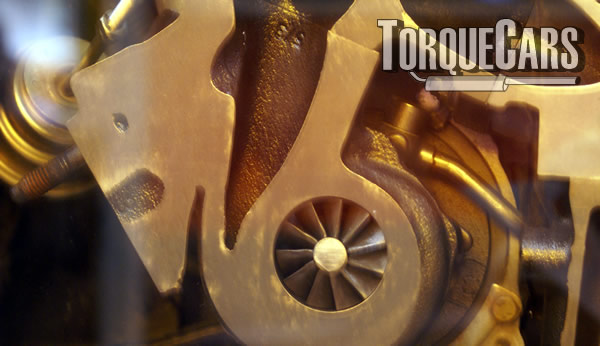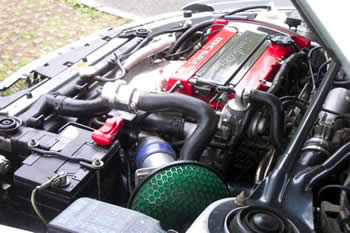Anti Lag systems explained.
"Everything you needed to know about Anti Lag on a turbo engine"
When you lift off the throttle the engine power cuts, and the turbo starts to spool down.
From this low spool state there is a delay while the turbo spins up again before it can provide any useful boost.
The aim of a driver is to get a fast throttle response and avoid any delay in putting down the power.
ALS or Anti lag is a solution to this problem, but not something TorqueCars recommends on a road car.
So what is ALS and how does it work? What are the advantages and disadvantages of ALS?
Anti lag was devised to keep the turbo spinning in a throttle off position. A very late ignition spark (~30° retart and overfuelling causes the flame front to exit the engine through the open exhaust port.

This fast moving charge keeps the turbo spinning quite quickly and ready to provide boost as soon as the throttle is pressed again.
In a rally car this is a great way to keep the power on after a sharp corner where you'll need boost immediately. Formerly a driver had to employ left foot braking and press the throttle to keep the engine revs up.
 ALS keeps the turbo spinning so you have boost on tap as soon as you need it.
ALS keeps the turbo spinning so you have boost on tap as soon as you need it.
This is a great way to kill your stock engine, as the turbo and exhaust temps will dramatically increase whilst the anti lag is on.
If you fit your engine with uprated components then ALS is potentially a good option if you want a very fast throttle response.
The aim of an ALS system is to maintain pressure in the inlet manifold and or keep the turbo spinning. Pressures of 0 to 1.5 bar [without it you have a vacuum on closed throttle] can be achieved with some ALS systems.
Anti lag has many implementations, here are the primary options
Throttle kick or throttle bypass
Ignition is retarded typically to around 35-45 degrees ATDC, this prevents much of the expansion in the cylinder so pressure and temps will still be high when the exhaust valves open.
This keeps the engine running (but only just) and provides a small amount of torque to the crank. The higher temps increase pressure and keep the turbo spinning at higher RPM's so there is less lag when the throttle is open.
Due to the way this work, the high pressure pulses and high temps engine life is typically reduced. Designing the exhaust and turbo to resist these high temperature extremes is an essential.
ALS should also switch off when engine coolants reach high temperatures so as to avoid many of these issues.
Inlet Bypass or secondary air injection
This method was used in F1 racing by Ferrari and the WRC Lancer Evo III and Toyota's GT Four Celica.
It involved fitting a bypass valve to feed air from the turbocharger to the exhaust, which keeps the turbo spinning. This solution is quite neat as the temperature extremes of throttle kick are avoided completely.
For this reason it was used in many road cars, especially those which were designed and sold for Homologation requirements, although the ALS was inactive on most road cars, it can be fairly easily implemented as all the valves and pipes are present.
D-Valve Intercooler and Turbo bypass
By fitting a one way check valve before the throttle body air can be diverted away from the Intercooler and Turbo, during a vacuum phase.
This means you get more air at the turbine side of the turbo because the additional air combusts more.
When the throttle is pressed, the intake pressure becomes positive closing the valve.
If you use a MAF and are not applying this in a speed-density configuration you should feed air via the MAF sensor to keep the fuel air ratios within tolerance.
Fuel Dump & Ignition Retardation at WOT
This is ideal for spooling the turbo up between gear changes or off the line, so applies more in drag racing, or if you want to build the ultimate launch control.
Ignition is retarded and extra fuel is dumped which delays the combustion event. This later combustion occurs much closer to the exhaust turbine and results in a much faster spool up at lower RPM's provided the engine is not under load.
It is often set to switch in with clutch operation so it kicks in between gearchanges.
The FD IR ALS method holds the throttle fully open, so is not effective at partial throttle and is best left for launch and gearchanges.
This method is very harsh on the Turbine and manifold due to the extremes of pressure and heat, and as the burn is much later you will often get flames and popping through the exhaust. If you have a catalyst this method is not recommended as it will kill the catalytic convertor.
Motor Generator Unit Heat method.
This has been used on modern F1 V6 engines and is a very effective and tidy solution, but has as yet to find it's way into road cars.
It uses two motor generators (kinetic and heat) and literally uses an electric motor to keep the turbine spinning when off throttle.
It effectively removes any lag you would otherwise experience in a turbo and it converts the heat energy to battery stored electric power, reducing the heat problem associated with ALS systems.
So you need to weight up the advantages and disadvantages of each of these antilag systems before installing one in your car.
The primary considerations are....
Cons of anti lag
- Turbo and exhaust temps are usually raised from 700° to over 1500° causing metal fatigue, oil degradation and premature exhaust wear.*
- The sheer pressure caused by anti lag will test your exhaust joints and show any weak spots.
- Lower engine and turbo life and worse reliability**.
- You will kill any catalyst fitted (hence why ALS is not suitable for road cars.)
- You may need an electronic servo for your brakes as these will be ineffective on an ALS equipped car.
Benefits
- Lots of boost on tap from relatively low RPM engine speeds.
- Less engine braking when off throttle.
- Some will appreciate the exhaust pop noises and flames.
*The heat generated is similar to the heat produced after a hard drive, it's just that this happens when you are off throttle when the car would usually have a chance to cool down a little.
**Many cars fitted with ALS have lasted 8-9 years of daily use without issue. So although reliability is compromised you're only expecting say half the normal life expectancy from these components. Most turbos and exhausts are uprated anyway on ALS fitted cars so can cope with the extra heat. Don't expect OEM parts to survive as long though.
Modern systems in cars create a way for the exhaust gases to reflow through the engine and keep the turbo spooling. EGR has the benefits of lower exhaust temps than in an anti lag system but it doesn't generally provide quite as much of a boost as ALS but is a very credible alternative.
ALS or Anti lag systems were being phased out due to tighter regulations in many motorsports events.
Thankfully the ALS continues to evolve and we are still seeing new innovations and designs to address the turbo lag problem.
Most ALS kits for road cars give very little of a noticeable boost at idle, make a lot of noise and compromise reliability.
Please Check out my YouTube channel, we're regularly adding new content...
PLEASE HELP: I NEED YOUR DONATIONS TO COVER THE COSTS OF RUNNING THIS SITE AND KEEP IT RUNNING. I do not charge you to access this website and it saves most TorqueCars readers $100's each year - but we are NON PROFIT and not even covering our costs. To keep us running PLEASE Donate here
If you liked this page please share it with your friends, drop a link to it in your favourite forum or use the bookmarking options to save it to your social media profile.
Feedback - What do You Think?
Please use our forums if you wish to ask a tuning question, and please note we do not sell parts or services, we are just an online magazine.
Help us improve, leave a suggestion or tip
Please watch this video and subscribe to my YouTube channel.
3 Responses to “Anti lag systems”

 Click to accept YouTube Cookies & Play.
Click to accept YouTube Cookies & Play.
Very engaging explanation. I submit that it doesn’t make sense to alter the engine timing with OEM components – and if one is going to install uprated components such as fuel injectors, and fuel and exhaust manifold, why not just twincharge the engine and get similar benefit with less wear? Just a thought.
Anti lag system. Is it smart or safe to install anti lag function on a bone stock 2012 wrx hatch for obvious reasons to shoot out flames here and there. Thoughts?
It’s a good way to kill a catalyst! Any unburnt fuel, or unclean combustion will eventually ruin a catalyst which in most countries is a legal requirement. However for off road use the catalyst can be removed. Personally I’d only use an antilag setup on a track/competition car.